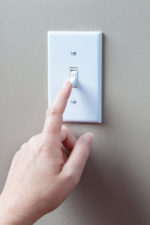Essential Electrical Outlet Safety Tips
Electrical outlets are the unsung heroes of our modern homes. After all, they provide the power we need to run our gadgets, appliances, lighting, and complete essential everyday tasks.
However, many people often take them for granted, overlooking the importance of using and maintaining them properly. To help you keep your home secure, here are some essential outlet safety tips for proper usage and maintenance.

Do regular inspections
To help identify issues before they become true hazards, make sure you routinely inspect the various outlets both inside and outside your home. Even just a quick glance once or twice a year can help you spot any loose or damaged parts, which you’ll want to fix as soon as possible. Some problems, such as a cracked cover, you can take care of yourself, but if you notice any wiggly outlets, exposed wiring, or charring on or around the outlet, it’s time to call an electrician to make the necessary repairs.
Avoid overloading
One of the most common mistakes people make is plugging too many devices, especially high voltage ones, into one outlet via a multi-outlet converter, power strip, or extension cord. This can overwhelm the outlet, which can in turn result in electrical shorts or fires. Always make sure you distribute the load across several different outlets and avoid connecting multiple extension cords or power strips to each other, otherwise known as daisy chaining. And if you have any appliances or electronics that will be plugged in for an extended period of time, connect them directly to the outlet whenever possible and never use an extension cord; these are only meant to be temporary solutions, not permanent fixtures in your home.
Install GFCIs
Ground fault circuit interrupters (GFCIs) are crucial in areas that are exposed to moisture, such as your kitchen, bathrooms, laundry room, garage, and various outdoor spots. This type of outlet is designed to shut off power at that location if it detects an electrical fault, thereby preventing shocks and potential hazards. If your home lacks GFCIs in these specific spaces, consider having them installed by a licensed electrician.

Childproof unused outlets
If you have young children or any that often visit your home, childproof any unused outlets to prevent accidents. You can use outlet plug covers or tamper-resistant outlets to ensure that curious little fingers can’t access the sockets. This simple tactic could reduce the risk of electrical accidents in your home and even save someone’s life.
Safely unplug items
It may seem like common sense, but when you unplug an item from an outlet, avoid pulling the cord, which can cause the plug to bend or wires in the cord to break. Instead, always grab the base of the plug and slowly pull it away from the wall.
Take extra outdoor precautions
Beyond installing GFCIs, make sure all your outdoor outlets are raised off the ground to prevent any flooding or water damage. Check that each one has a proper weatherproof cover to protect it from the elements, including rain, snow, and extreme temperature fluctuations. And never use an indoor extension cord outdoors, only ones that are intended for outdoor use.
Know when to upgrade
Outdated outlets might not be equipped to handle the demands of modern technology, so if you have any two-pronged outlets in your home, you’ll want to have them updated to three-prong or GFCI ones. Two-pronged versions lack the third grounding prong, which is pivotal for reducing the risk of electrical shock and circuit malfunction.
By following these essential electrical outlet tips, you can help ensure the safety and functionality of your home for years to come. And if you’re ever in doubt, consider consulting with an electrician, who can help address any electrical concerns you may have.


















